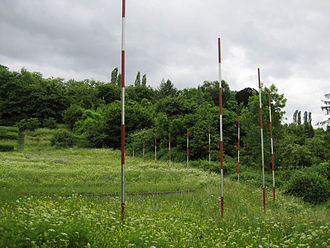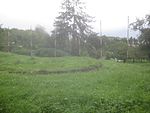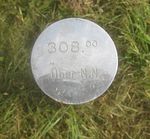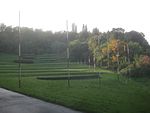Under the bars
| Under the bars | |
|---|---|
| Surname | Under the bars |
| object | Landscape architectural installation |
| Artist | Hans Dieter Bohnet |
| Construction year | 1993 |
| location | Stuttgart , Wartberg |
| Height above sea level | 308 m |
| material | stainless steel |
| Dimensions | Rod thickness: 8 cm Rod height : approx. 1–7 m Length of the rod row: 80 m Distance between rods: approx. 5 m |
| Number of bars | 17th |
Among the bars is a landscape architecture installation by the sculptor Hans Dieter Bohnet on the Wartberg site in Stuttgart. The installation consists of 17 measuring rods, the ends of which mark the height of 308 m above sea level in an amphitheater- like area .
The Unter den Stangen art station is one of the art stations that were set up for the 1993 International Horticultural Exhibition (IGA '93) in the green U park in Stuttgart and were retained after the exhibition. In addition to this station, Hans Dieter Bohnet also created the neighboring art station Im Keuper as well as the fountains and floor sculptures of the Egelsee art station .
Note: Numbers in brackets, e.g. B. (12), refer to the corresponding numbers in the plan of the Wartberg area.
location
The Unter den Stangen art station (5) is located on a slope of the Wartberg , which slopes down towards the valley like an amphitheater. In the West, is located in the immediate vicinity of the art station in Keuper (4), also of Hans Dieter Bohnet, and in the east the Kunststation cave hole of Michael Singer (6).
The Wartberg is located in the Stuttgart-Nord district of Stuttgart and functions within the Green U , a closed green space eight kilometers in length, as a link between the Leibfriedschen Garten and Rosensteinpark in the east and the Höhenpark Killesberg in the west.
Access
The art station can u. a. can be reached in the following ways (also suitable for the disabled):
- From the Löwentorbrücke tram stop, follow the stairs to the Bombaystegen (21) and then the left branch of the Menzel-Bourgiba-Weg (22) to the art station.
- From the Höhenpark Killesberg you can get to the art station via St.-Helens-Steg (19), St.-Helens-Weg (17) and Straßburger Weg (23).
description
The installation is located in a piece of terrain on the Wartberg, which is bordered to the west and south by Straßburger Weg (23) and to the northeast by Stangenbach (13). It consists of the row of poles , which runs like a transparent curtain through the area, and the event hollow , which takes up most of the slope.
Row of bars
→ See also: Lyrikstation Halt Stanga .
The installation consists of 17 poles 8 cm thick, which transparently define the space over a distance of 80 m at 5 m intervals from the top of the slope down to the valley . The poles are made of stainless steel and are alternately painted red or natural, at intervals of one meter each, so that they look like measuring sticks that were "forgotten when the site was built". The cut surface of the bars is sealed with a polished stainless steel disc. It bears the engraved inscription “308. 00 / Above NN “and signals the same altitude of 308.00 m as above for all poles .
The row of bars begins near a rest area with three groups of benches on a cul-de-sac on Straßburger Weg (23) and not far from the source of the Stangenbach (13). The beginning is marked by a low concrete wall at the end of the bench groups, which also functions as a poetry station and bears an inscription with a poem by Peter Schlack . The wall is aligned with the row of bars and, like this, shows with its upper edge the height of 308 m above sea level .
The highest point of the row of bars is marked by a small, red stick. This means that the terrain at this point is about 307 m above sea level (1 m below 308 m). The row continues partially parallel to the Stangenbach and at the end it circles the event hollow .
The last two bars flank the Straßburger Weg (23). They have 6 ½ red-silver markings, i. H. The Strasbourg way is at an altitude of about 301.5 m (6.5 m below 308 m). The six following bars off the Straßburger Weg flank the event basin and are about 7 m high. At approx. 301 m, this point is the lowest within the row of poles (7 m under 308 m). Overall, there is a difference in level of about 5.5 m between the first and the last pole.
Poetry station Halt Stanga by Peter Schlack = wall to the right of the seating area, middle: first pole of the art station.
Event trough
The terrain, the topography of which is defined by the transparent pole wall, is a gentle hill that is shaped like an amphitheater . Six broad terrace arches, which can be imagined as rows of seats, nestle concentrically around a circular lawn with a diameter of approx. 15-20 m and bordered by a low natural stone wall. During the IGA '93 this place was intended as an event trough. It offered seating for 400 guests and was equipped with a covered stage and large parasols for the audience. After the IGA, the event trough has apparently been forgotten and was no longer used for events or as an open-air stage.
concept
In connection with the description of his two other Wartberg projects ( Im Keuper , Egelsee ), Hans Dieter Bohnet also commented on the concept on which his pole wall is based:
“The adjoining area 'Under the Poles' with its amphitheater-like shape inspired me to use poles (equal to measuring rods) to define the space transparently and at the same time to draw attention to the topography. Because all poles end at a height of 308 00 above sea level. Possibly another irritating moment in the landscape. "
literature
- Ralf Arbogast: Stuttgart, the green experience. Recreational landscapes, parks and garden shows in the past and present . Tübingen 1993, p. 87 (event trough), 92.
- Rebekka Bücheler: Hans Dieter Bohnet, Kubus 1978 . In: Bärbel Küster (Ed.); Wolfram Janzer (photos): Sculptures of the 20th century in Stuttgart . Heidelberg 2006, pp. 74-77, here: 76.
- Christoph Gunßer: The international horticultural exhibition Iga Expo '93 in Stuttgart . In: Deutsche Bauzeitung db. Journal for Architects and Civil Engineers 127.1993, Issue 6, pp. 14–28, here: 6.
- Hans Luz: Planning and design of the permanent systems . In: Building for Agriculture 1993, Issue 1, pp. 8–18, here: 8 (event trough).
- Hans Luz: Wartberg / Steinberg and Leibfriedscher Garden . In: Elisabeth Szymczyk-Eggert: Gardens and Parks in Stuttgart , Stuttgart 1993, pp. 100-105, here: 104-105 (event tray).
- Frank R. Werner: The art concept: Art-Nature-Drama . In: Garten + Landschaft 103.1993, issue 7, pp. 36–39, here: 37.
- Frank Werner (editor); Christof Luz (essay); Hans Luz (essay): Art-Nature-Drama. Earthworks beyond the IGA 1993 Stuttgart , Stuttgart 1993, p. [9] (photo), [57].
Web links
- Hans Dieter Bohnet: Unter den Stangen, 1993 on the website of the city of Stuttgart .
Individual evidence
- ↑ The ten art stations that have been preserved are: Near the beech , Bienengarten , Egelsee , Gate of Hope , Grottenloch , Im Keuper , Sanctuarium , Stangenwald , Unter den Stangen, Villa Moser .
- ↑ The plan is based on an OpenStreetMap map.
- ↑ Dimensions in part from #Stuttgart 2013 , italics: formulation according to Hans Dieter Bohnet in #Werner 1993.3 , p. [57].
- ↑ #Stuttgart 2013 .
- ↑ a b # Werner 1993.3 , p. [57].
- ↑ Stangenbach is used here to denote the actually nameless stream.
- ↑ #Arbogast 1993 , p. 87.
Coordinates: 48 ° 48 ′ 11.3 " N , 9 ° 10 ′ 34.2" E








